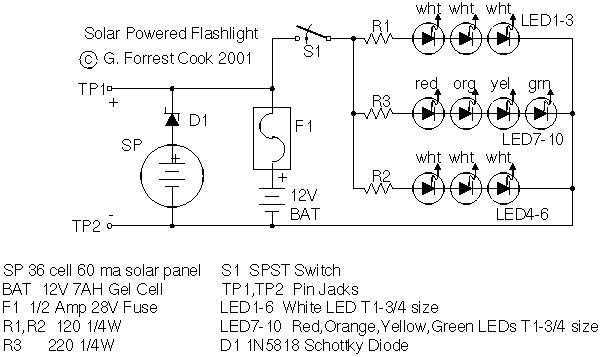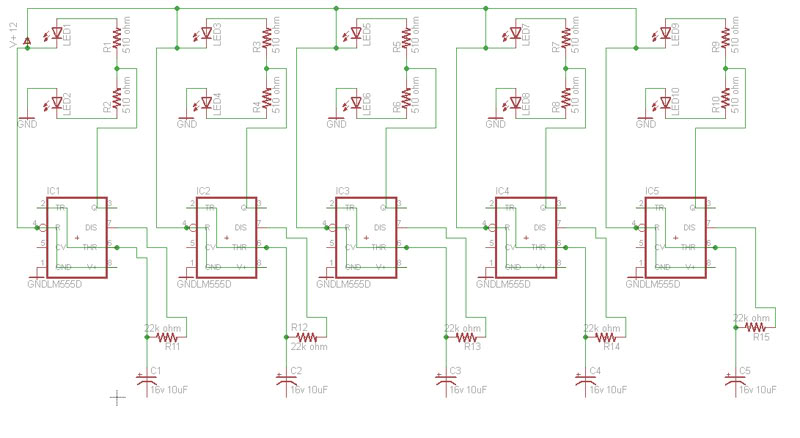
Solar Charged LED Utility Light

Tired of always spending money on flashlight batteries only to have them fail just when you need them? Try this simple circuit out. It would make an excellent science fair project. The white LEDs are quite bright, they provide enough light to illuminate a small room at night. The LEDs produce a nicely focused beam. You can read by the light of this device. The red, orange, yellow and green LEDs broaden the lamp's color spectrum to produce a slightly warmer color temperature. More: The box also doubles as a 12V power source and can run other small loads such as a transistor radio. This project was built with the Simpler is Better approach, the materials are common and many substitutions are possible. Specifications Operating Vol
This circuit design utilizes a combination of white and colored LEDs to create an efficient lighting solution that operates on a 12V power supply. The main components include a series of high-brightness white LEDs, which are arranged to provide focused illumination suitable for tasks such as reading. The inclusion of red, orange, yellow, and green LEDs enhances the color spectrum, allowing for warmer light output, which can be more comfortable for prolonged use in low-light environments.
The circuit is powered by a 12V battery, which not only serves to illuminate the LEDs but also functions as a power source for other small electronic devices, such as a transistor radio. This dual functionality makes the design particularly versatile for both lighting and powering small loads.
In terms of construction, the circuit is designed with simplicity in mind, emphasizing the use of readily available materials. The LED configuration can be adjusted based on the desired brightness and color temperature. Resistors are typically included in series with the LEDs to limit current and prevent damage, ensuring longevity and reliability of the light source.
When assembling the circuit, attention should be paid to the polarity of the LEDs, as they are polarized components. Proper heat dissipation should also be considered, especially when using high-brightness LEDs, to prevent overheating and ensure optimal performance. Overall, this project exemplifies a practical application of basic electronics that can be easily replicated and modified for various uses.Tired of always spending money on flashlight batteries only to have them fail just when you need them? Try this simple circuit out. It would make an excellent science fair project. The white LEDs are quite bright, they provide enough light to illuminate a small room at night. The LEDs produce a nicely focused beam. You can read by the light of this device. The red, orange, yellow and green LEDs broaden the lamp`s color spectrum to produce a slighly warmer color temperature.
The box also doubles as a 12V power source and can run other small loads such as a transistor radio. This project was built with the Simpler is Better approach, the materials are common and many substitutions are possible. Specifications Operating Vol 🔗 External reference
This circuit design utilizes a combination of white and colored LEDs to create an efficient lighting solution that operates on a 12V power supply. The main components include a series of high-brightness white LEDs, which are arranged to provide focused illumination suitable for tasks such as reading. The inclusion of red, orange, yellow, and green LEDs enhances the color spectrum, allowing for warmer light output, which can be more comfortable for prolonged use in low-light environments.
The circuit is powered by a 12V battery, which not only serves to illuminate the LEDs but also functions as a power source for other small electronic devices, such as a transistor radio. This dual functionality makes the design particularly versatile for both lighting and powering small loads.
In terms of construction, the circuit is designed with simplicity in mind, emphasizing the use of readily available materials. The LED configuration can be adjusted based on the desired brightness and color temperature. Resistors are typically included in series with the LEDs to limit current and prevent damage, ensuring longevity and reliability of the light source.
When assembling the circuit, attention should be paid to the polarity of the LEDs, as they are polarized components. Proper heat dissipation should also be considered, especially when using high-brightness LEDs, to prevent overheating and ensure optimal performance. Overall, this project exemplifies a practical application of basic electronics that can be easily replicated and modified for various uses.Tired of always spending money on flashlight batteries only to have them fail just when you need them? Try this simple circuit out. It would make an excellent science fair project. The white LEDs are quite bright, they provide enough light to illuminate a small room at night. The LEDs produce a nicely focused beam. You can read by the light of this device. The red, orange, yellow and green LEDs broaden the lamp`s color spectrum to produce a slighly warmer color temperature.
The box also doubles as a 12V power source and can run other small loads such as a transistor radio. This project was built with the Simpler is Better approach, the materials are common and many substitutions are possible. Specifications Operating Vol 🔗 External reference





